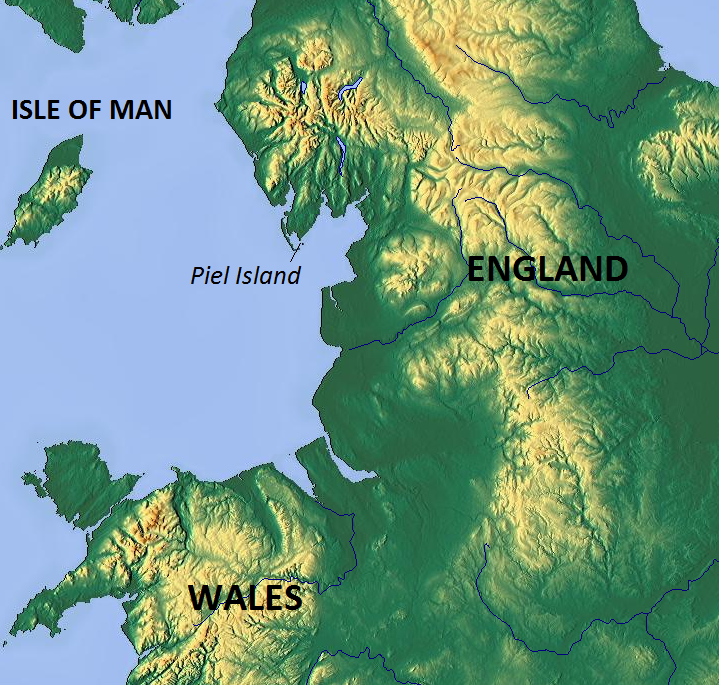
Click the above logo to return to the main site
Taking care not find himself cut off due to the changing tide, Boardman visited a number of locations, including Hilbre Island in West Kirby, Ynys Llanddwyn off the coast of Anglesey and Piel Island in Cumbria.

Hilbre Island's name derives from the dedication of a medieval chapel built on the island to St. Hildeburgh, an Anglo-Saxon holy woman, after which it became known as Hildeburgheye or Hildeburgh's island.[4] Hildeburgh is said to have lived on Hilbre Island in the 7th century as an anchorite. Some consider that she never existed, while others equate her with Saint Ermenhilde, the mother of Saint Werburgh to whom Chester Cathedral is dedicated,[5] or St Edburga of Mercia, daughter of the pagan king Penda.


In the Middle Ages Piel was known as Fowdray (or Fouldrey or Fowdrey) island. This name would seem to be derived from the Old Norse words fouder, meaning "fodder", and ay or oy, meaning "island". The island's known history dates from the time of King Stephen who, in 1127, gave the island to the Savignac monks as part of a land grant for an abbey. When the Savignacs became part of the Cistercian order later in the 12th century, the island came under the control of the Cistercians at nearby Furness Abbey.
The island is very rich in legends, and in particular the association with Dwynwen. The name Llanddwyn means "The church of St. Dwynwen". Dwynwen is the Welsh patron saint of lovers, making her the Welsh equivalent of St. Valentine. Her Saint's day is 25 January and is often celebrated by the Welsh with cards and flowers. The island bears the ruined remains of St Dwynwen's Church.
MEDIEVAL VILLAGERS MUTILATED THE DEAD TO STOP THEM RISING, STUDY FINDS
Archaeological research may represent first scientific evidence of English practices attempting to protect the living from the dead
Simon Mays, skeletal biologist at Historic England, said: “The idea that the Wharram Percy bones are the remains of corpses burnt and dismembered to stop them walking from their graves seems to fit the evidence best. If we are right, then this is the first good archaeological evidence we have for this practice.”
This article was amended on 3 April 2017. An earlier version said the study was published in the Journal of Archaeological Science.
hvered wrote:Archaeologists have been theorising about a collection of mutilated corpses in a deserted medieval village called Wharram Percy, half-way between York and Bridlington in the Yorkshire Wolds.
Not long after renouncing his claim to Denmark, the former Earl of Northumbria, Tostig Godwinson, brother of the newly chosen English king Harold Godwinson, pledged his allegiance to Harald and invited him to claim the English throne. Harald went along and entered Northern England in September 1066, raided the coast and defeated English regional forces in the Battle of Fulford near York. Although initially successful, Harald was defeated and killed in an attack by Harold Godwinson's forces in the Battle of Stamford Bridge. Modern historians have often considered Harald's death at Stamford Bridge, which brought an end to his invasion, as the end of the Viking Age. Harald is also commonly held to have been the last great Viking king, or even the last great Viking
In 1072, William I of England rode north and forced Malcolm to sign the Treaty of Abernethy. In return for swearing allegiance to William, Malcolm was to be given estates in Cumbria. The peace secured by the treaty was an uneasy one and in 1093 Malcolm once again invaded northern England. An arranged meeting with the new King of England, William Rufus, to settle a dispute over the Cumbrian territories failed to materialise. Malcolm left for Scotland angry and humiliated. He returned to England shortly after with an army and laid waste to Northumberland. On his way back to Scotland he was attacked by the Earl of Northumbria. At the Battle of Alnwick, Malcolm was killed.
After Harold's defeat, the English in the north were not defeated and would not obey William. Danish fleets sailed up the Rivers Tyne and Wear, the Scots marched to Gateshead, and the English in Durham and Northumberland gathered together on the Black Fell.This was in the year 1068. William marched north with his army. The battle took place on the Black Fell. The hardest fighting was on Shadon's Hill, Washington. After a terrible conflict, William won. The Danes sailed away in their ships and the Scots fled home.Then the fierce Normans destroyed everything. Villages were burnt, men, women and children were killed. The land was left desolate.
.

Users browsing this forum: Bing [Bot] and 1 guest